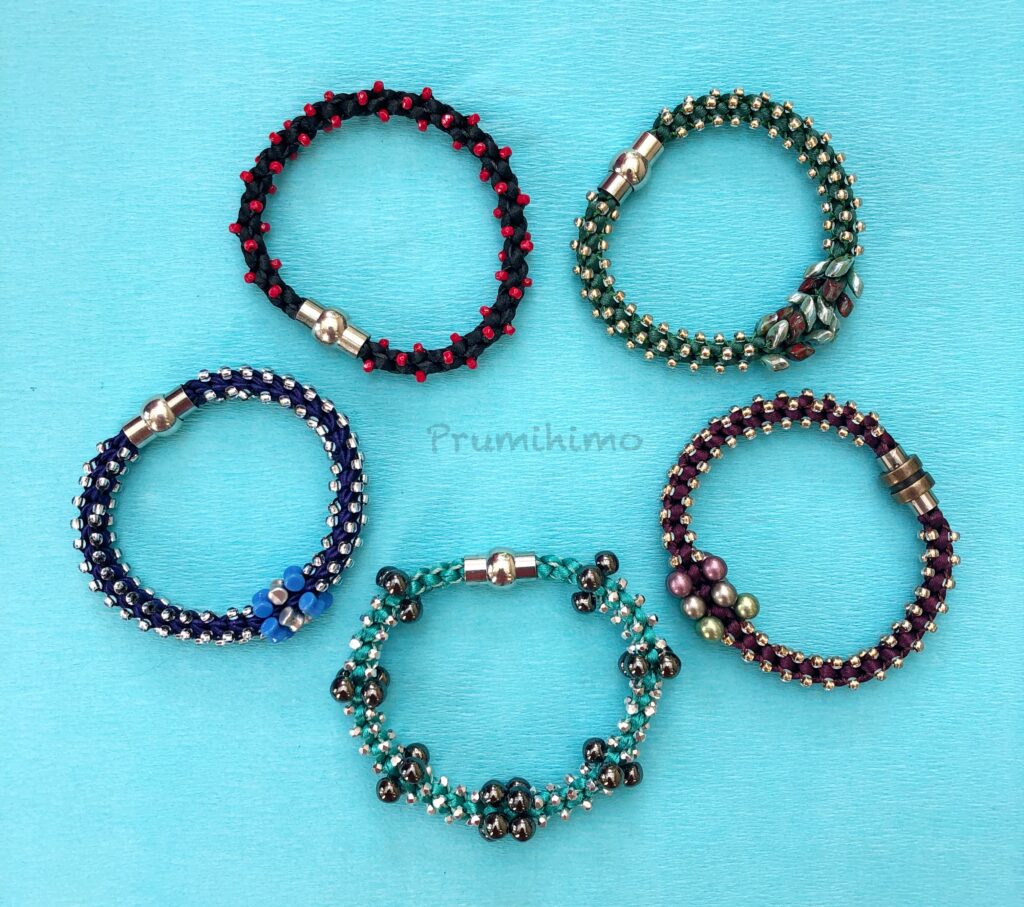
Here we are now in the final week of the braid-along and I have been amazed and delighted by the wide range of beautiful designs we have seen so far. The participants have really started to dig into their stashes to experiment and as a result everyone can benefit from the results and learn from each other. I have seen so much creativity, enthusiasm and progress. Well done to everyone and I can’t wait to see what is made in the final week.
The featured technique for week four is Quadruple Beading on the Prumihimo disk. This involves adding beads on all four sides of the braid in straight rows. When I look through my own work and the work of others on the Prumihimo disk I can see that most of the braids are either Double Beading or Triple Beading. I can also see many braids made using the Single Beading method, but far fewer made using the Quadruple Beading method, so this braid-along is going to be a great opportunity to look at exploiting the possibilities of this under used technique. The reason for this set up to be less used than others is because it does not have the unbeaded side of the braid, which sits next to the skin, so you need to think about how smooth and comfortable the beads you intend to use might be. The advantage of having beads next to the skin is that oils from the skin or beauty products are held away from the braid, which is particularly useful when using very pale coloured cords.
The first consideration is the coverage you wish to achieve. It is possible to completely cover the underlying braid with beads or to have braid showing in between the beads, to a greater or lesser degree. To achieve the look you want you need to match up the width of the cord with the size of the beads. To cover the braid the beads need to be larger and the cord thinner. For sparser coverage use smaller beads and wider cord. Exact instructions cannot be given because there are so many variables, but you can look back over the braids you have made so far to assess the relationship between the beads and the cords. Trialling different combinations is the best way to work out what works for you and for the materials you have to hand. This guidance can be used as a starting point.
For full coverage try 1.5- 2mm satin cord and long magatama beads
For sparse coverage try 2mm satin cord and size 8 or size 11 seed beads
The second consideration is the length of the braid and this is a particular issue for bracelets. For the previous braids you have been able to repeat the length that worked for the first one, but when you have beads on the inside of the braid it will need to be longer. This photo shows the effect of having beads on the inside of the braid. All three bracelets fit my wrist perfectly, but the length of each one has been adjusted to accommodate the number and size of beads on the inside of the braid.

Here are the instructions for week 4
- Watch this video.
- Set up your disk, allowing approximately 10% more cord than used in previous bracelets.
- Thread beads onto all 4 beading cords.
- Add in beads from both top and bottom cords at numbers 3 and 4. For wider spacing try adding in beads from the top and bottom at 3 in one sequence and then from the top and bottom at 4 in the next sequence.
- Check the length of your braid carefully before removing it from the disk. It will need to be slightly longer than previous braids and this will depend on the number and size of beads you have used.
- Twisting is more likely to occur when you have beads on all four sides of the braid. If your braid is slightly twisted you can straighten it using the steaming method. Click here to find instructions.
- Attach your clasp. If you need help attaching your clasp please watch this video.
- POST YOUR WORK IN THE WEEK 4 POST IN THE GROUP.
- If you like what you have made, try making another one with different beads, different cords or with different spacing. Now that all four bead placements have been learnt you can try mixing them in one braid.
- Admire and learn from the work of other members.

